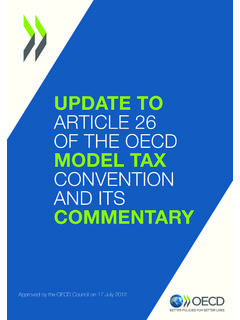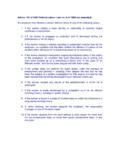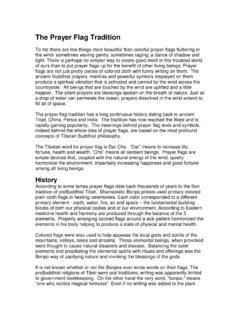Transcription of Gender-Related Persecution Guidelines - UNHCR
1 Distr. GENERAL. HCR/GIP/02/01. 7 May 2002. Original: ENGLISH. Guidelines ON INTERNATIONAL PROTECTION: Gender-Related Persecution within the context of article 1A(2). of the 1951 Convention and/or its 1967 Protocol relating to the Status of Refugees UNHCR issues these Guidelines pursuant to its mandate, as contained in the Statute of the Office of the United Nations High Commissioner for Refugees, in conjunction with article 35 of the 1951 Convention relating to the Status of Refugees and article II of its 1967 Protocol. These Guidelines complement the UNHCR Handbook on Procedures and Criteria for Determining Refugee Status under the 1951 Convention and the 1967 Protocol relating to the Status of Refugees (Reedited, Geneva, January 1992).
2 They further replace UNHCR 's Position Paper on Gender-Related Persecution (Geneva, January 2000) and result from the Second Track of the Global Consultations on International Protection process which examined this subject at its expert meeting in San Remo in September 2001. These Guidelines are intended to provide legal interpretative guidance for governments, legal practitioners, decision-makers and the judiciary, as well as UNHCR staff carrying out refugee status determination in the field. Gender-Related Persecution within the context of article 1A(2) of the 1951 Convention and/or its 1967 Protocol relating to the Status of Refugees I.
3 INTRODUCTION. 1. Gender-Related Persecution is a term that has no legal meaning per se. Rather, it is used to encompass the range of different claims in which gender is a relevant consideration in the determination of refugee status. These Guidelines specifically focus on the interpretation of the refugee definition contained in article 1A(2) of the 1951. Convention relating to the Status of Refugees (hereinafter 1951 Convention ) from a gender perspective, as well as propose some procedural practices in order to ensure that proper consideration is given to women claimants in refugee status determination procedures and that the range of Gender-Related claims are recognised as such.
4 2. It is an established principle that the refugee definition as a whole should be interpreted with an awareness of possible gender dimensions in order to determine accurately claims to refugee status. This approach has been endorsed by the General Assembly, as well as the Executive Committee of UNHCR 's 3. In order to understand the nature of Gender-Related Persecution , it is essential to define and distinguish between the terms gender and sex . gender refers to the relationship between women and men based on socially or culturally constructed and defined identities, status, roles and responsibilities that are assigned to one sex or another, while sex is a biological determination.
5 gender is not static or innate but acquires socially and culturally constructed meaning over time. Gender-Related claims may be brought by either women or men, although due to particular types of Persecution , they are more commonly brought by women. In some cases, the claimant's sex may bear on the claim in significant ways to which the decision-maker will need to be attentive. In other cases, however, the refugee claim of a female asylum-seeker will have nothing to do with her sex. Gender-Related claims have typically encompassed, although are by no means limited to, acts of sexual violence, family/domestic violence, coerced family planning, female genital mutilation, punishment for transgression of social mores, and discrimination against homosexuals.
6 4. Adopting a gender -sensitive interpretation of the 1951 Convention does not mean that all women are automatically entitled to refugee status. The refugee claimant must establish that he or she has a well-founded fear of being persecuted for reasons of race, religion, nationality, membership of a particular social group or political opinion. II. SUBSTANTIVE ANALYSIS. A. BACKGROUND. 5. Historically, the refugee definition has been interpreted through a framework of male experiences, which has meant that many claims of women and of homosexuals, have gone unrecognised.
7 In the past decade, however, the analysis and understanding of sex and gender in the refugee context have advanced substantially in case law, in State 1. In its Conclusions of October 1999, No. 87 (n), the Executive Committee not[ed] with appreciation special efforts by States to incorporate gender perspectives into asylum policies, regulations and practices; encourage[d] States, UNHCR and other concerned actors to promote wider acceptance, and inclusion in their protection criteria of the notion that Persecution may be Gender-Related or effected through sexual violence.
8 Further encourage[d] UNHCR and other concerned actors to develop, promote and implement Guidelines , codes of conduct and training programmes on Gender-Related refugee issues, in order to support the mainstreaming of a gender perspective and enhance accountability for the implementation of gender policies. See also Executive Committee Conclusions: , Refugee Women and International Protection, 1985; , Refugee Protection and Sexual Violence, 1993;. (g), General Conclusion on International Protection, 1995; (o), General Conclusion on International Protection, 1996; and (t), General Conclusion on International Protection, 1997.
9 2. practice generally and in academic writing. These developments have run parallel to, and have been assisted by, developments in international human rights law and standards,2. as well as in related areas of international law, including through jurisprudence of the International Criminal Tribunals for the former Yugoslavia and Rwanda, and the Rome Statute of the International Criminal Court. In this regard, for instance, it should be noted that harmful practices in breach of international human rights law and standards cannot be justified on the basis of historical, traditional, religious or cultural grounds.
10 6. Even though gender is not specifically referenced in the refugee definition, it is widely accepted that it can influence, or dictate, the type of Persecution or harm suffered and the reasons for this treatment. The refugee definition, properly interpreted, therefore covers Gender-Related claims. As such, there is no need to add an additional ground to the 1951. Convention 7. In attempting to apply the criteria of the refugee definition in the course of refugee status determination procedures, it is important to approach the assessment holistically, and have regard to all the relevant circumstances of the case.















